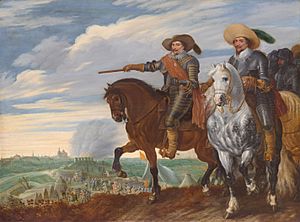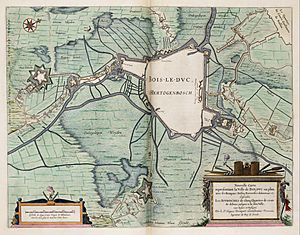Siege of 's-Hertogenbosch facts for kids
Quick facts for kids Siege of 's-Hertogenbosch |
|||||||
|---|---|---|---|---|---|---|---|
| Part of the Eighty Years' War and the Anglo–Spanish War | |||||||
 The defeated Spanish garrison leaving 's-Hertogenbosch, 17 September 1629 by Pauwels van Hillegaert 1635. Oil on Canvas. |
|||||||
|
|||||||
| Belligerents | |||||||
| Commanders and leaders | |||||||
(Spanish Relief Army) |
|||||||
| Strength | |||||||
|
3,000 infantry 4,000 armed civilians |
24,000 infantry of which:
4,000 cavalry 116 cannons |
||||||
| Casualties and losses | |||||||
|
1,200 killed 1,200 diseased and injured |
Unknown | ||||||
The Siege of 's-Hertogenbosch (also called the Siege of Bois-Le-Duc) happened in 1629. It was a major event during the Eighty Years' War and the Anglo–Spanish War. During this siege, an army from the Netherlands and England captured the city of 's-Hertogenbosch. This city had been loyal to the King of Spain since 1579. It was an important part of the Spanish Netherlands.
Contents
Why the Siege Happened
The Twelve Years' Truce, a period of peace, ended in 1621. The Dutch leader, Maurice of Orange, helped start the Thirty Years' War in Germany. The Habsburg rulers, who controlled Spain, wanted to punish the rebellious Dutch Republic. They tried to block the Dutch from their trade routes by land.
's-Hertogenbosch was a very strong fortress in this area. A lot of money was spent to make its defenses even better. The land around the city was marshy and wet. This made it seem impossible to use common siege methods. Digging trenches and tunnels was thought to be out of the question. Maurice had tried to capture the city twice before and failed.
The blockade caused money problems for the Dutch Republic. So, they tried to hurt their enemy in other ways. In 1628, a Dutch admiral named Piet Pieterszoon Hein had a huge success. He captured the Spanish treasure fleet. This made the Dutch Republic much richer.
With new money, the Dutch leader, Frederick Henry, planned a big attack. He wanted to break the Habsburgs' spirit by taking their main stronghold in the Netherlands. Most people thought he would attack Breda, which the Habsburgs had taken back in 1625. His choice of 's-Hertogenbosch was a big surprise.
The Siege Begins
Frederick Henry started the siege in April 1629. He brought an army of 24,000 foot soldiers and 4,000 cavalry (soldiers on horseback). About 13,000 to 14,000 of these troops were from Britain. English commanders included Horace Vere and Edward Cecil. Scottish commanders included William Brog and Walter Scott, 1st Earl of Buccleuch.
Frederick Henry also hired 4,000 farmers to help. These farmers helped create a clever plan. He redirected the two main rivers, the Dommel and the Aa, away from the city. He built a huge, forty-kilometer-long dike (a wall to hold back water). This dike completely surrounded the fortress.
This created a dry area called a polder. Then, he used mills, mostly powered by horses, to drain the water. Once the ground was dry enough, his soldiers could dig trenches closer to the city walls. Important visitors from all over Europe came to watch. They admired this new and amazing way to conduct a siege.

Spanish Efforts to Help
The Habsburg leaders did not just sit by. They sent a large army to help the city. This army was led by Hendrik van den Bergh, who was Frederick Henry's Catholic cousin. Van den Bergh's army reached the city in July.
However, Van den Bergh quickly realized that Frederick Henry's defenses were too strong. Frederick Henry had used a similar tactic successfully in 1627. Van den Bergh tried to trick Frederick Henry into leaving. He invaded the Dutch Republic through the Veluwe region. He even captured Amersfoort on August 14. But when his supply base was captured, he had to retreat.
The City Falls
Meanwhile, the Dutch and English forces kept digging closer to the city. They continuously fired cannons at the city's defenses. During the siege, they fired 28,517 cannonballs. On July 18, the large Fortress Isabella was captured. The next day, Fort Anthony also fell.
The 2,500 soldiers defending the city made repeated attacks. But the attackers slowly moved closer to the southern city gate. They dug tunnels under Bastion Vught, a part of the city's defenses. In the early morning of September 11, a huge explosion happened. This caused a large break in the city walls. On September 14, the city's military governor, Anthonie Schetz, surrendered.
What Happened Next
After the city fell, Bishop Michael Ophovius asked Frederick Henry to allow Catholics to practice their religion freely. Frederick Henry himself would have liked to grant this freedom. He wanted to gain support in the Spanish Netherlands. However, strong opposition from Calvinists meant this was not allowed. Only nunneries could remain open until the last nun living there in 1629 had died.
The fall of 's-Hertogenbosch was a huge blow to Spain. It was their worst defeat in the North since the Spanish armada in 1588. Because of this loss, Spain's power in the North began to weaken. Frederick Henry was encouraged by his success. He started a series of other sieges. His cousin, Van den Bergh, even joined his side after being accused of treason.
Many English soldiers who fought in this siege became important leaders later. They fought in the English Civil Wars. These included Thomas Fairfax, Jacob Astley, and George Monck. These men learned a lot about warfare from Horace Vere during this siege.
Even though most of its people remained Catholic, 's-Hertogenbosch stayed under Dutch control. It was part of the Generality Lands until 1794. That's when French revolutionary forces captured it. Only then did the Batavian Republic grant equal rights to Catholics. The former Duchy of Brabant is still divided today. Part of it is in Belgium and part is in the Netherlands.
Images for kids
See also
 In Spanish: Asedio de Bolduque (1629) para niños
In Spanish: Asedio de Bolduque (1629) para niños



